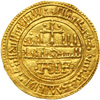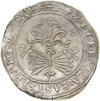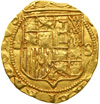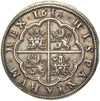
|
Sale 46
The Millennia Collection
| Lot |
Photo |
Description |
Realized |
Lot 820 |
 |
Spain. Moribitino (Mancus), ND. Fr-101; C & C 997. 3.86 grams. 25.45 mm. Alfonso VIII of Castille, 1158-1214. Toledo mint. Dated Safar era 1222 (1184 AD), Pseudo-kufic legend with cross flanked by pellets above and ALF below, marginal legend " Struck at Toledo in 1222 Safar era". Five line legend with star flanked by pellets below. Alfonso reigned over a large Muslim population, an the types were acceptable to the merchant classes that dealt with both Muslims and Christians. The legends are in Arabic, with a Christian cross. Rare early type. NGC graded AU-58.
Estimated Value $3,500 - 4,000.
(*).
View details and enlarged photos
| Realized
$4,198 |
Lot 821 |
 |
Spain -- Castilla and Leon. Dobla of 35 Maravedis, ND (Seville). Fr-108; Burgos-369; cf. Heiss I, p. 57,5. 4.53 grams. Pedro I, 1350-1368. Castle within gothic tressure; underneath, "S" mintmark. Reverse: Rampant lion left within gothic tressure. A stunning example of 14th-century numismatic art! Minted on an unusually broad, full flan, evenly struck with deep details right to the broad rims beyond the complete legends showing crisp letters. Even the die-centering dot is bold. Clearly among the finest known, and an important piece. NGC graded MS-64.
Pedro I, called "the Cruel," directed a number of assassinations against those who would remove him from rule. Partly responsible were his short-term (counted in days!) alliances with wives, as well as mistresses. After Pedro's exile in 1367, Edward the Black Prince sided with Pedro and reinstated him briefly as king. The chief treasurer during his reign was the financial wizard, of Jewish background, Samuel Halevi Abulafia. This authority given to Jewish financial experts and mintmasters was quite normal in medieval Spain, and included a three-generation succession of political ministers from the Abravanel family.
Estimated Value $4,000 - 5,000.
Illustrated in Money of The World, coin 77.
View details and enlarged photos
| Realized
$9,488 |
Lot 822 |
 |
Spain -- Houses of Castille & Leon. Gold Dobla de la Banda, ND (Seville). Fr-112; Cayon-1428. 4.60 grams. Juan II, 1405-1454. Shield with ornamented diagonal band, held in the mouths of two lions. Reverse: Quartered arms of Castille and Leon. Much better than typical strike, on a real nice, broad flan, showing all important details. A few faint handling marks, otherwise as struck. Scarce. NGC graded MS-64.
Medieval Iberia was made up of a patchwork of kingdoms, with Castile and Aragon being the major powers. Juan II inherited Castile, the largest kingdom on the peninsula, as well as the smaller kingdom of Leon, to the northwest of Castile. His uncle Ferdinand, who, with Juan's mother, served as regent until he came of age, was named King of Aragon in 1412. Both Aragon and Navarre were fierce rivals of Castile, while Portugal and France allied themselves with Castile. The defeat of Aragon and Navarre in the battle of Olmedo was the high point of Juan's reign, but his greatest claim to fame is probably that he was the father of Isabella (by his second wife, Isabel of Portugal), whose marriage to Ferdinand of Aragon (in 1469) and their accession to their respective thrones (in 1479) united the two powerful kingdoms and formed the basis of modern Spain.
Estimated Value $1,500 - 2,000.
View details and enlarged photos
| Realized
$4,600 |
Lot 823 |
 |
Spain -- Houses of Castille & Leon. Gold 1 Enrique, ND (Seville). Fr-116; Cayon-1452 var. 4.59 grams. Enrique IV, the Weak, 1454-1474. King enthroned facing, holding upright sword. Reverse: Quartered arms of Castille and Leon. Reverse legend variant, not listed in Cayon as being associated with obverse legend. Crisp, even strike in attractive style, on a full flan showing all the letters of the legends in detail, and a sharply impressed central portrait. Rare, moreso in this exceptional state of preservation. NGC graded MS-63.
Enrique (Henry), son of Juan II of Castile and Maria of Aragon, a weak and dissolute ruler, in 1440 married Blanca of Navarre but their union ended because he was unable to father children. The paternity of a daughter (Juana) born during his second marriage to Juana of Portugal was questioned; she was considered to be the fruit of an adulterous relationship between the queen and Beltran de la Cueva, and the populace refused to accept her accession to the throne. Isabel, sister to the king, was named as his successor.
Isabel married Ferdinand of Aragon and they reigned as joint sovereigns (her kingdom of Castile was, after all, bigger than his kingdom of Aragon). They became Spain's most famous rulers because of their patronage of Columbus and their re-conquest of Granada from the Moors. The fact that they also expelled all the Jews from their kingdoms in 1492 is not mentioned as often.
Estimated Value $5,000 - 6,000.
Illustrated in Money of The World, coin 81.
View details and enlarged photos
| Realized
$11,213 |
Lot 824 |
 |
Spain. Gold 4 Excelentes, ND (Segovia). Fr-125; Clemente & Cayon-2803; CCT-11. 14.00 grams. "Los Reyes Catolicos," Ferdinand V & Isabel I, 1476-1504. Crowned and draped busts of Ferdinand & Isabel facing each other; aqueduct symbol above, "A" to right; between them, "1111" with pellet above. Reverse: Crowned arms of Spain, borne by nimbate eagle behind. An unusually good strike with the important dual portraits unsually clear, and most pleasing overall with almost all of the letters of the legends sharp, on a broad flan. Very rare, more so in this exceptionally fine quality. NGC graded MS-63.
It was assumed in late medieval Europe that religious conformity was a prerequisite for successful government. Spain was probably more religiously diverse than any other European nation. To establish religious conformity, the Jews and Muslim Moors would have to be displaced. In the year of Colombus' first voyage to the New World, 1492, Spain expelled its Jews and captured the Moorish stronghold of Granada. Ferdinand and Isabella were named the "Catholic" rulers for these deeds, and Spanish culture would be irrevocably changed. Here is an indelible memento of those historic moments.
Estimated Value $20,000 - 25,000.
Illustrated in Money of The World, coin 80.
View details and enlarged photos
| Realized
$48,300 |
Lot 825 |
 |
Spain. Gold 2 Excelentes, ND (Seville, after 1497). Fr-129; Clemente & Cayon-2776. 14.00 grams. Ferdinand V & Isabel I, 1476-1504. "Los Reyes Catolicos," Crowned and draped busts of Ferdinand & Isabel facing each other; "X" symbol above; between them, "S". Reverse: Crowned arms of Spain, borne by nimbate eagle behind. A wonderfully even strike, with the symbols crisp, the legends sharp right to the distinct rims, the portraits also bold, with the metal lustrous and unusually fine. All in all, a fabulous example of this classic piece! NGC graded MS-63.
In 1469, Princess Isabel of Castille married Prince Ferdinand of Aragon, and when they ascended their respective thrones, a decade later in 1479, their union led to the most powerful confederation of Christian kingdoms on the Iberian peninsula.
The rather unusual state of their political relationship is clearly depicted in their numismatic portraits -- their marriage or "union" depicted as a regal "embrace" by these images of the royal couple that were engendered in the court's minting workshops. The royal couple are always shown in profile, face to face, in order to emphasize the strict equality of their powers. Traditionally a queen would be behind her husband, and facing the same direction. However, in this situation, Isabel's inherited kingdom was far and away the larger and more powerful of the two territories, and so it compensated for her secondary status as a woman. In fact, Isabel expressly stipulated in her marriage contract that this was the design to be used on their coinage, which obviously was agreed to by Ferdinand, as evidenced by the extant examples of their coinage. Here is one of the finest examples to be found.
Estimated Value $4,000 - 5,000.
View details and enlarged photos
| Realized
$6,613 |
Lot 826 |
 |
Spain. Houses of Castille & Aragon. 8 Reales, ND, Assayer D (Seville). Clemente & Cayon-2698; Cayon-2380. 27.40 grams. Ferdinand V & Isabela, 1474-1516. Crowned arms of Aragon and Castille, dividing "S" and small "o" over "VIII". Reverse: Beribboned bundle of arrows and yoke, assayer mark in field. Very well struck up, with only slight doubling evident on both sides and quite minimal flatness. An unusually neat and eye-appealing example of this often hastily struck coin. NGC graded AU-55.
The decisons of the Medina del Campo, on June 13, 1497, established a new monetary system for unified Spain, based on the Maravedi as the unit of account. Additional requirements were that each mint's product bear both the mint's mark and that of the assayer as a guarantee of quality. From this new system emerged the gold Excelente de la Granada, at about 3.40 grams, equivalent to 375 maravedis, plus the silver Real at about 3.24 grams, worth 34 marevedis, as well as its multiple, the silver Duro of 8 Reales, at around 25.92 grams. Spanish coins, such as the 8 Reales which appears in this lot, were sent along with colonists and conquistadors to the New World for temporary use until the colonies might begin producing their own coins. This wouldn't happen until 1536, with the beginning of production in Spain's first colonial mint in Mexico City. Thus the Spanish-minted coins can be considered a "bridge type" of coinage with regard to New World currency since they provided both the model and the format for much of what was struck in the middle and southern hemispheres for over two centuries. Here, then, is an important architypal issue which was replicated almost endlessly in the New World.
Estimated Value $3,000 - 4,000.
View details and enlarged photos
| Realized
$3,910 |
Lot 827 |
 |
Valencia. Fr-86; Heiss Vol II,p.190#3. 3.44 grams. 22.15 mm. Ferdinand II, 1504-1516. After Death; of Isabel (1479-1504). Obv: Crowned bust of King facing left, within beaded circle. The dot in the hair is the compass mark for the aiding in the puching of the legend. Leg: +FERDINANUVS x EI Graciax Reverse Arms of Valencia. Leg: +VALENCIE xMA IORICARVM x SE. Boldly struck with a beautiful portrait. Rare this nice. NGC graded AU-50.
Valencia as part of the kingdom of Aragon, continued to issue its own coins even after the union of Aragon and Castille. Yet few coins were minted. This is a great rarity.
Estimated Value $3,500 - 4,000.
(*).
View details and enlarged photos
| Realized
$5,520 |
Lot 828 |
 |
Spain. 1 Escudo De'Oro, ND. Fr-153. Seville mint. 3.36 grams. 21.51 mm. Carlos I and Juana, 1516-1556. Obv: Crowned arms, with S to right for Seville and symbol to left. Reverse Jerusalem cross within quadrefoil, mintmark tower. Struck on small flan, legends partly visible. NGC graded AU-55.
Estimated Value $1,500 - 2,000.
(*).
View details and enlarged photos
| Unsold |
Lot 829 |
 |
Spain. 8 Reales, 1614 over 07 (Segovia). Dav-4394; Cayon-4640. 26.63 grams. Philip III, 1598-1621. Crowned Hapsburg shield. Reverse: Quartered arms of Castille and Leon in tressure. A few very trivial laminations on the reverse, typical of this period. Otherwise, a choice machine strike -- the royal crests really sharp, overall the design even and finely centered with high rims. Lovely old two-shaded toning, with smokey russets and deep golds on the obverse, lighter on the reverse. Scarce, interesting overdate. NGC graded AU-58.
Philip III may have been the most incompetent ruler Spain experienced during its long period of monarchy, but fortunately Philip died young (at age 42), so his policies had little lasting effect. He left all decisions of state to his confidant, the Duke of Lema, who was as corrupt as Philip was innocent. At this time Spain received tremendous wealth from its colonies, most of it dissipated through mismanagement. What remains of the New World's mines exists mainly on these regal coins.
Estimated Value $1,500 - 1,750.
View details and enlarged photos
| Realized
$2,013 |
Lot 830 |
 |
Spain. Silver Cinquentin, or 50 Reales, 1635-R (Seville). Cayon-6173; Dav-LS567; KM-81.5. 172.88 grams. Philip IV, 1621-1665. Asseyor, Rafael Savan. Crowned Hapsburg shield. Reverse: Quartered arms of Castille and Leon in tressure. Some modest laminations on the obverse, typical of this period and especially this series. Otherwise, a superior strike on choice metal, finely toned with original reflective fields. One of the finest known, an elegant specimen. Extremely rare.
Only 12 examples are known of this date, with 6 of them being in public collections. Likewise, of these only one example is in a condition comparable to the above, this too in a public collection (Coin Cabinet of Cataluna, no. 29387). Thus this coin is the finest known in private hands. Too large for holder. NGC graded MS-60.
Philip IV inherited a country that held the most overseas territory of any in Europe, but was also the most disorganized of any European power. What Spain needed was to stay out of foreign wars and organize its vast holdings in a cohesive manner. What Spain did was to spend Philip's entire reign at war with the Netherlands, France, Portugal, the Protestant forces in the Holy Roman Empire, and England. These wars were justified by Spain's rulers as being God's will to establish Catholic orthodoxy but they essentially destroyed the Spanish fortunes that came from the New World and decimated the homeland populace. There are perhaps no finer emblems in silver of the Spanish main than this magnificent, huge coin.
Estimated Value $35,000 - 40,000.
Ex Coin Galleries, New York, Feb. 20, 1981 Mail Bid Sale, lot 1259; Sidney W. Smith & Sons, Miami, Florida, June 1982, lot 3815 (where it realized $15,000); Illustrated in Money of The World, coin 95.
View details and enlarged photos
| Realized
$66,125 |
Lot 831 |
 |
Spain. Gold 8 Escudos, 1713-M (Seville). Fr-247; KM-247.2. 26.95 grams. Philip V, 1700-1746. Bourbon coat of arms within crowned shield. Reverse: Cross within quadrilobe. Attractive and lustrous. A beautiful example, blessed by an unusually even strike, lustrous and truly pleasing. Rare. NGC graded MS-64.
Philip was the first of the French Bourbon kings to rule in Spain. When the Spanish ambassador was introduced to Philip, he knelt and lauded his new king via a long speech in Spanish. Louis XIV of France was present as well. Ironically, the French king understood the Spanish speech while the Spanish king did not. As we see on this wonderful gold coin, the royal bloods of Europe were blending, and alliances were changing the texture of the old world just as the New World was coming into its own.
Estimated Value $4,000 - 5,000.
View details and enlarged photos
| Realized
$9,200 |
Lot 832 |
 |
Spain. Gold 320 Reales, 1810-RS (Madrid). Fr-300; CCT-2; KM-545. 26.98 grams. Joseph Napoleon, 1808-1814. Filleted head left. Reverse: Crowned arms, Order of Golden Fleece around, the new denomination to the sides of the shield. Centers slightly soft in strike, the fields clean and the portrait generally pleasing, lustrous with brilliant fields. Attractive, old red to brown toning in the recesses. Very rare, and in a quality rarely encountered. NGC graded AU-55.
Here is an example of the larger, new-denomination coin minted in Madrid during the Napoleonic era, when Joseph Napoleon assumed control. Spain's then-current, debased coinage, known as vellón (an alloy of silver and copper), was a continuing source of unutterable confusion in Spanish finance. During Joseph Napoleon's tenure, an attempt was made to organize the currency on a more rational basis, with all coins being some form of reales. The new coinage was minted in 1, 2, 4, 10 and 20 reales, in 90% silver. The higher value 80, 160 and 320 reales gold coins were in a slightly lower quality gold, about 21 karat. Circulation of Napoleonic coinage was limited to Spain. It was not used in the colonies and certainly did not make its way to the United States. With the Revolution the old coinage passed away and was replaced by the decimal system, the peseta and céntimo being equivalent to the French franc and centime. Many prices continued to be quoted in the traditional reales, which were then rated at 25 céntimos (about 5 cents of American money). Virtually no citizen outside of Spain ever saw a large gold coin such as this regal piece.
Estimated Value $15,000 - 20,000.
Illustrated in Money of The World, coin 127.
View details and enlarged photos
| Realized
$33,350 |
Lot 833 |
 |
Spain. Silver 20 Reales, 1810-I.A. (Madrid). Dav-308; Calbeto-505 (RR); Cr-92.2. Joseph Napoleon. Bare bust left. Reverse: Crowned crest dividing value. Exceedlingly rare variety with assayer initials "I.A." -- one of the classic rarities of the Napoleonic period of Spain. Finer than the 1974 Calico/Spink/GdM Auction specimen, in EF condition, which realized 18,000 SF! This specimen is lustrous, well struck, a beautiful coin with only minor scuffing, and pleasing silver-toned surfaces; we believe it is the finest known example. NGC graded MS-60.
Napoleon divided Spain's coinage into three parts. Joseph Bonaparte, Napoleon's brother, issued coins from Madrid and Seville, this being the largest denomination and representing one ruling area. King Ferdinand VII issued other coins from Spanish mints.
Estimated Value $1,000 - 1,200.
Ex Irving Goodman Collection.
View details and enlarged photos
| Realized
$5,750 |
Lot 834 |
 |
Spain. Silver 20 Reales, 1810-A.I. (Madrid). Dav-308; Cr-92.2; KM-551.2. Joseph Napoleon Bonaparte, 1808-1814. Bare head left. Reverse: Crowned shield. Fully lustrous with lovely light gray toning. Very scarce this nice. A beautiful example! NGC graded MS-62.
Estimated Value $1,000 - 1,200.
Ex Irving Goodman Collection.
View details and enlarged photos
| Realized
$2,013 |
Lot 835 |
 |
Spain. Silver 5 Pesetas, 1810 (Barcelona). Dav-310; KM-69; Cr-L17; Calbeto-4. Barcelona Under French Occupation by Napoleon's army. Arms of Barcelona in Wreath. Reverse: Value and sprays in wreath. Surface haymarking due to striking stress. Original mint luster with pleasing silvery surfaces, and quite scarce this nice. NGC graded MS-64.
This coin represents the Napoleonic occupation as existed from 1808 to 1814.
Estimated Value $1,000 - 1,200.
Ex Irving Goodman Collection.
View details and enlarged photos
| Realized
$3,720 |
|
|